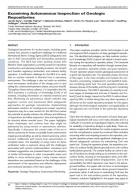Details
- Identification
- ISSN: 1977-5296, DOI: 10.3011/ESARDA.IJNSNP.2022.5
- Publication date
- 1 June 2022
- Author
- Joint Research Centre
Description
Volume: 64, issue 1, June 2022, pages 48-63
Authors: Jacob Benz1, Camille Palmer2, HaliAnne McGee-Hilbert1, Chris (Yu Hsuan) Lee2, Ravi Kumar2, Geoffrey Hollinger2, Nicole Benker1
1Pacific Northwest National Laboratory (PNNL), 2Oregon State University
Abstract:Geological repositories for nuclear waste, including spent nuclear fuel, present a significant challenge for traditional International Atomic Energy Agency (IAEA) safeguards tools due to their inaccessibility and demanding operational conditions. The IAEA has been working closely with Member State organizations currently involved in repository construction and planning including Euratom, the Finnish and Swedish regulatory authorities, and relevant facility operators. A verification challenge for the IAEA is to verify that no nuclear material is diverted from a repository environment. The challenge is also not static as activities must encompass verification of the design prior to and during the construction/operation phase, and post backfill. Throughout these various phases, it is imperative that the IAEA maintains a continuity of knowledge (CoK) of all material, including information on material inventory and flow. Monitoring via autonomous robotic vehicles may augment current and envisioned IAEA safeguards approaches for geologic repositories. Implementing automated solutions for underground nuclear repository inspection may be a new venture for the IAEA but carries the potential to greatly enhance the efficacy and efficiency of inspections and allow inspectors’ time and expertise to be directed where needed most. This paper highlights these challenges and outlines how they might be addressed by using remote or autonomous vehicles. Specifically, it discusses the current state of the art in robotic autonomy for known or partially known environment mapping and patrolling, as well as shared autonomy, where humans collaborate with closed loop autonomation to complete tasks. The feasibility of using rovers for these verification tasks is explored, along with the challenges associated with system implementation. Hardware and software suggestions are provided based on the adoption of similar technologies in other comparable areas and ability to close technical gaps. Lastly, human-robotic interactions are considered based on the challenges of the environment of the repository and effective deployment and continued operation of the robot system.
Keywords: Geologic Repository, Autonomous Monitoring
Reference guideline:
Benz, J., Palmer, C., McGee-Hilbert, H., Lee, C.Y.H., Kumar, R., Hollinger, G., & Benker, N.(2022, June). Examining Autonomous Inspection of Geologic Repositories.
ESARDA Bulletin - The International Journal of Nuclear Safeguards and Non-proliferation, 64(1), 48-63. https://doi.org/10.3011/ ESARDA.IJNSNP.2022.5

